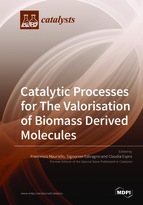Catalytic Processes for The Valorisation of Biomass Derived Molecules
A special issue of Catalysts (ISSN 2073-4344). This special issue belongs to the section "Biomass Catalysis".
Deadline for manuscript submissions: closed (31 December 2018) | Viewed by 38079
Special Issue Editors
Interests: synthesis and physicochemical characterization of nanostructured materials and their catalytic application for the reductive valorization of lignocellulosic biomass
Special Issues, Collections and Topics in MDPI journals
Interests: His research activity carried out in both industrial and academic research laboratories is mainly addressed to the heterogeneous catalysis and in particular to noble metals supported on high surface area oxides catalytic systems. A significant part of its interest is focused on the development of selective catalysts for low environmental impact processes and new materials and technologies in the energy sector
Interests: heterogeneous catalysis; catalytic conversion of renewable biomass for the production of bulk chemicals; development of innovative catalytic materials for sensing applications
Special Issues, Collections and Topics in MDPI journals
Special Issue Information
Dear Colleagues,
In the last decades, industrial chemistry is changing its fossil nature into a new green and sustainable identity by using renewable resources for the sustainable production of building blocks and materials. To this regard, inedible lignocellulosic biomasses have attracted a lot of attention being abundand resources that are not in competition with agricultural land and food production and, therefore, can be used as starting renewable material for the production of a wide variety of platform chemicals. The three main components of lignocellulosic biomasses are cellulose, hemicellulose and lignin, complex biopolymers that can be converted into a pool of platform molecules including sugars, polyols, alchols, ketons, ethers, acids and aromatics. A lot of technologies have been explored for their one-pot conversion into chemicals, fuels and materials. However, in order to develop new catalytic processes for the selective production of desired products, a complete understanding of the molecular aspects of the basic chemistry and reactivity of biomass derived molecules is still crucial. This Special Issue aims to cover recent progress and advances in both reductive and oxidative valorization of cellulose, hemicellulose and lignin model molecules promoted by novel heterogeneous catalysts. In this framework, theoretical and computational models on reaction pawtways leading to a target product and the interactions between reactants and catalyst surface will be important subjects for this Special Issue.
Dr. Francesco MaurielloProf. Dr. Signorino Galvagno
Dr. Claudia Espro
Guest Editors
Manuscript Submission Information
Manuscripts should be submitted online at www.mdpi.com by registering and logging in to this website. Once you are registered, click here to go to the submission form. Manuscripts can be submitted until the deadline. All submissions that pass pre-check are peer-reviewed. Accepted papers will be published continuously in the journal (as soon as accepted) and will be listed together on the special issue website. Research articles, review articles as well as short communications are invited. For planned papers, a title and short abstract (about 100 words) can be sent to the Editorial Office for announcement on this website.
Submitted manuscripts should not have been published previously, nor be under consideration for publication elsewhere (except conference proceedings papers). All manuscripts are thoroughly refereed through a single-blind peer-review process. A guide for authors and other relevant information for submission of manuscripts is available on the Instructions for Authors page. Catalysts is an international peer-reviewed open access monthly journal published by MDPI.
Please visit the Instructions for Authors page before submitting a manuscript. The Article Processing Charge (APC) for publication in this open access journal is 2700 CHF (Swiss Francs). Submitted papers should be well formatted and use good English. Authors may use MDPI's English editing service prior to publication or during author revisions.
Keywords
- Lignocellulosic biomasses
- model molecules
- hydrogenation
- hydrodeoxygenation
- hydrogenolysis and transfer hydrogenolysis
- aqueous-phase reforming
- oxidation
- computational models








